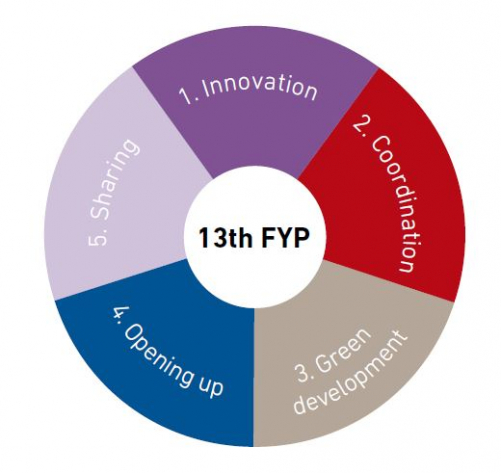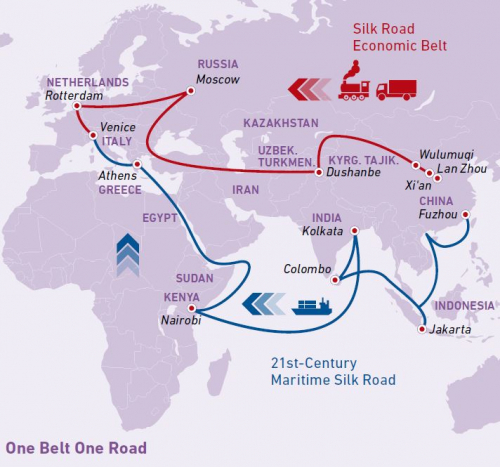
The Future Development of China
The world is talking about economic developments regarding web 2.0 and industry 4.0. In China, the digits 13.5 are often mentioned. The number stands for the 13th five-year development programme (also cited as 13.5 or 13th FYP) for China. China’s National People’s Congress examined and discussed the 13.5 on March 5, 2016. The 13.5 programme joins in a row of FYPs (formerly called ‘Five-Year Plans’) and should be understood as a guideline China's near-future development (2016-2020). The 13.5 will affect China's population as well as her international partners, and will draw attention as it is the first five-year programme of the current President Xi Jinping.
The Chinese Communist Party (CCP) has issued an eight-chapter, 22,000-Chinese-character proposal, which presents the core of the new FYP and discloses five guiding principles i.e. innovation, coordination, green development, opening up, sharing.
According to China’s National People’s Congress statement, China should develop a moderately prosperous society and modern socialist country. The first 100-year goal should be achieved by the 100th birthday of the Chinese Communist Party in 2021, and the second 100-year goal should be achieved by the 100th birthday of the People's Republic of China in 2049. A modern socialist country should be developed that can be described as prosperous, democratic, culturally advanced and harmonious.
The first 100-year goal of a moderately prosperous society is defined through the comprehensive development of a civilisation's economy, political structure, culture, society and ecology. The 10 aims of such a society are: (1) by 2020, the per capita GDP is more than 3,000 USD. (2) Average disposable income of urban and suburban residents is 18,000 RMB. (3) Average net income of rural residents is 8,000 RMB. (4) Reduction of the Engel coefficient to lower than 40%. (5) A 30 square metre per capita housing area for urban and suburban residents. (6) Urbanization growth level is higher than 50%. (7) Penetration rate of personal computer is 20%. (8) University and college enrolment rate is 20%. (9) 2.8 doctors per 1000 inhabitants. (10) Rate of subsistence allowance in urban and suburban areas is above 95%.
What are the principles and aims in the 13.5 proposal?
Great improvements should be made in all industries. The Chinese economy should grow at a medium or high rate, more than 6.5% on average. The GDP and average income of urban and rural residents by 2020 should be twice that of 2010. Consumption is seen as more important for economic development, regional poverty should be resolved, and general improvements in social and environmental conditions should be achieved.
Based on achievements and difficulties encountered during the last FYP (12.5 / 2011-2015), the 13.5 plan with its five guiding principles was developed. The plan includes various measures and promising aims not only for China but for the whole world.
Principle Innovation
Chinese consumption style should be “intelligent, green, healthy and safe”. Financial regulations and the fiscal system should be reformed and improved. The investment system must be optimised. Opportunites in foreign economic activity will be realised by concentrating on developing technology, standards, branding, quality and service. 13.5 suggests introducing outstanding investment programmes into China and supporting promising Chinese investments aboard. Manufacturing developments will be accelerated by implementing “Made in China 2025”. Key areas will be developed as a whole; key economic zones would be expanded, promising rural areas developed. Infrastructure will be further developed, including those of information and transportation. Monopolies will be opened up, for instance, electricity, telecommunication, transportation, petroleum, natural gas and municipal public utility. The “Internet Plus” strategy and Big Data revolution will be implemented to promote technology of ‘Internet of Things’ and applications. “Internet Plus” can be understood as a deep integration of “Internet + every traditional industry” based on information and communication technology.
Principle Coordination
13.5 fosters the balanced development of China in respect of regions and cities, and economic and social development. Support of less developed regions and cities should result in well-balanced growth. Coastal cities which are better developed should shift industrial capacities to Western regions, and improved infrastructure should help underdeveloped regions to prosper.
Principle Green development
China's aim is to develop a resource-saving and environment- friendly society.
This includes the saving of resources and protection of the environment. The Chinese economy is going green and will control carbon emissions strictly. The allocation systems of energy, water, drainage and carbon emissions is set to be improved. The strictest environmental protection and management systems of water resources will also be implemented in order to accelerate environmental rehabilitation. Electric vehicles will be promoted and energy-saving construction standards (e.g. green buildings) will be stricter. Investments will support renewable energies such as wind, solar, biomass, water and geothermal, as well as nuclear since CO² free energy will be promoted. The energy grid performance will thus improve due to these proposed energy savings.
Principle Opening up
Opening up is the answer to China's new economical position in the world. The 12.5 plan had a domestic focus, while the 13.5 introduces more international issues. For instance, building strategically mutual trust, developing trading cooperation and improving cultural exchanges. “One Belt, One Road” (OBOR) will be built to promote pragmatic global cooperation by land and sea from China to Europe. OBOR is the combined Silk Road Economic Belt and the 21st-century Maritime Silk Road. Based on bilateral and multilateral cooperation, the strategy is to build an international trade corridor inolving over 50 countries, and covering a population of more than 4 billion to foster the economy for all participants.
China`s Free Trade Zones (FTZ) will be expanded more quickly. At the same time, China will promote signing the high-standard Bilateral Investment Treaty (BIT) and judicial assistance treaty with more countries, and implement strategies regarding free trade zone. 13.5 proposes' good quality, good price, good bought in, good sent out’, introduction and provision of capital, technology and knowledge, and balance between import and export. Equipment manufacturing and service industries will be more developed. China will also open up the domestic market to a greater degree.
Principal Sharing
China will be developed by the people and the achievement will be shared among the people. Opportunities should be shared fairly and people’s basic livelihood should be guaranteed so that the whole society becomes moderately prosperous in general. Public services will be better shared, poverty programmes targeted for improvement, education will be developed equanimously, structural problems of employment moderated, social insurance, basic pension systems and medical insurance improved using different methods, medical treatment and public health systems reformed and food safety standards implemented. "Family Planning" will still be adhered to. “Family Planning” includes encouraging late marriages and childbirth, as well as a lower mortality birth-rate. The amendment that families are allowed to have a second child under certain conditions was passed in 2015 and will come into effect on June 1, 2016. Meanwhile, China will actively deal with its aging population and reduce the income gap. In addition, the on-going anti-corruption campaigns will contribute to the successful realisation of the proposed 13.5 plan.
Mehr erfahren?





